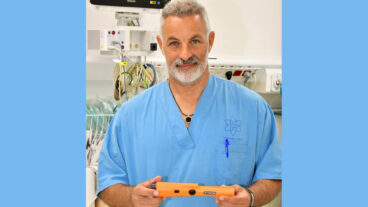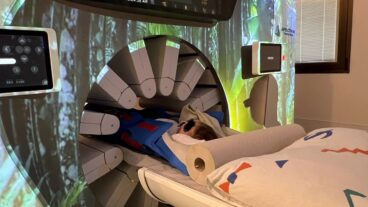‘Our system offers better efficacy and safety advantages, as well as the risk of far fewer complications over traditional drug and surgery therapies for glaucoma.’Glaucoma, like hearing loss, is one of those terrible inevitabilities of ageing. Nicknamed “the silent sight thief”, glaucoma is the second leading cause of blindness in the US, afflicting an estimated three million Americans aged 40 and over. Over 15 million more are at risk – especially those of African and Mexican-American descent.
There is no easy cure for the condition; current medical and surgical treatments are either risky or inadequate. But a breakthrough treatment for glaucoma may be waiting at the end of the tunnel, courtesy of Israeli startup IOPtima.
The company’s technology comes in the form of a laser known as the OT134, a medical device based on carbon dioxide laser technology – similar to laser technology used on the skin.
According to its developers, the OT134 device enables an eye surgeon with little expertise to easily operate on the eyes of a glaucoma patient, making the formerly complex operation as simple as going for a cataract operation.
While eye surgeons today are using laser treatment extensively, they apply it to correcting vision and not for treating physical abnormalities of the eye, explains IOPtima’s CEO Joshua Degani.
“Our application for treating the envelope of the eye itself is very original,” he told ISRAEL21c.
The idea of a carbon dioxide laser for treating glaucoma was originally devised by Prof. Ehud Assia, a professor at the Sackler Faculty of Medicine at Tel Aviv University, and director of the Ophthalmology Department at the Meir Medical Center in Kfar Saba.
Glaucoma is caused by excessive pressure in the eye, often brought on with age. The clear liquid that bathes the eye’s optic nerves flows through a meshwork, like a drain, in order to pass out of the eye. But as we get older, the fluid gets clogged in the meshwork and a pressure builds up. It can be so strong that it presses on the optic nerve causing extensive damage over time.
Only a small percentage of eye surgeons around the world have obtained the painstaking know-how required to relieve pressure from the eye with a surgical approach. The most efficient surgical technique is known as Trabeculectomy Non-Penetrating Deep Sclerectomy (TNPDS).
And Assia is one of the few eye surgeons in the world who can perform the procedure. It requires a surgeon to scrape off a thin layer of the wall of the eye, leaving only a razor thin layer (5%) intact. This layer has to be thin enough for the excess liquid to drain out of the eye and thick enough that the eye remains protected.
Performing such a surgery is like balancing on a tightrope: It is both difficult and extremely risky if something should go wrong. Eyes collapse, infections, cataract formations and more. That is why few choose to operate and opt to prescribe a long-term, but less-effective, drug alternative instead.
That’s where IOPtima’s lasers come in. Assia’s device will make it possible for eye-surgeons everywhere to become instant experts in a surgical technique that was once performed by a select few. It enables surgeons who aren’t trained in performing TSPDS to perform the procedure with ease.
Using the IOPtima device, the laser switches off the moment before the eye membrane is perforated – at exactly the same time when the liquid is able to pass through the membrane, but when the membrane is thick enough to keep the eye protected.
“It occurred to me that this would be a perfect fit for non-penetrating surgery, because the moment the CO2 laser came in contact with the intra-ocular liquid of the eye it would automatically shut off, and therefore prevent any serious damage,” says Assia.
After having his ‘Eureka’ moment, Assia developed the device and then took it to the boardroom, where he partnered with Bio-Light Life Science Investments to form IOPtima.
Now the company’s chief scientist, Assia and his team have conducted successful pre-clinical trials on 23 human patients in Israel. The initial results have been the talk of the town among eye surgeons worldwide, and some are using their clout to help organize human clinical trials in the United States, Canada and Europe. Among the collaborators are Prof. Mark Sherwoods from the University of Florida, as well Prof. Graham Trope from the University of Toronto.
On a more local level, IOPtima has consulted with such Israeli experts as medical laser specialist Prof. Abraham Katzir from the School of Physics and Astronomy at Tel Aviv University.
“Our system offers better efficacy and safety advantages, as well as the risk of far fewer complications over traditional drug and surgery therapies for glaucoma,” says CEO Degani, who brings with him personal insight on laser technology through extensive work in the field and a PhD in the area from Jerusalem’s Hebrew University.
Healthcare providers are likely to also welcome the IOPtima treatment. Medication against glaucoma amounts to $2-3 billion spent globally each year; it often fails because of low patient compliance and because in many cases it has limited long-term efficacy.
IOPtima’s treatment will also open up possibilities for glaucoma surgery not only in the US but in developing countries as well, especially where the costly prolonged treatments of eye drops are not possible.
“For them, yes, this would be a major achievement,” said Degani. “I think that the nicest thing about this is that it is going to make eye surgeries an appealing procedure both for patients and eye surgeons.
“In the past it was very difficult for eye surgeons to conduct such a surgery, and with great risks. Our laser will make it easy for glaucoma surgery to be done in a fast, convenient, effective and safe way.”![]()












